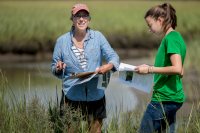
As ginkgo trees do, the one outside Carnegie Science Hall, across from Chase Hall, shed all its leaves within a few hours on Nov. 9. “It is beautiful,” said Assistant Professor of Biology Brett Huggett, who alerted us.
The Bates ginkgo was planted in 2003, and it’s the only one on campus. Bill Bergevin, the college’s landscape architect, chose the species with the faculty of Carnegie Science Hall in mind.
Video of the Bates ginkgo shedding its leaves on the morning of Nov. 9.
“By my limited knowledge and research, Ginkgo biloba is one of the few species living today of which fossilized records exist,” Bergevin says. In other words, the ginkgo is a “living fossil,” a phrase coined by Charles Darwin, with fossilized examples of the plant dating back some 270 million years.
Thanks to a recent story in The Atlantic, we can say that due to climate change, the Bates ginkgo is probably shedding its leaves later and later each year.
The Atlantic story notes that a favorite ginkgo tree at the University of New Hampshire is dropping its leaves around two weeks later than it did in the 1970s. The UNH ginkgo also dropped its leaves on Nov. 9, the morning after a hard freeze in New England (it got down to 19 degrees on the Bates campus), and it’s believed that temperature has something to do with the ginkgo’s leaf drop.
Here are then-and-now photos of the Bates ginkgo, on Nov. 9 and again the next morning:




